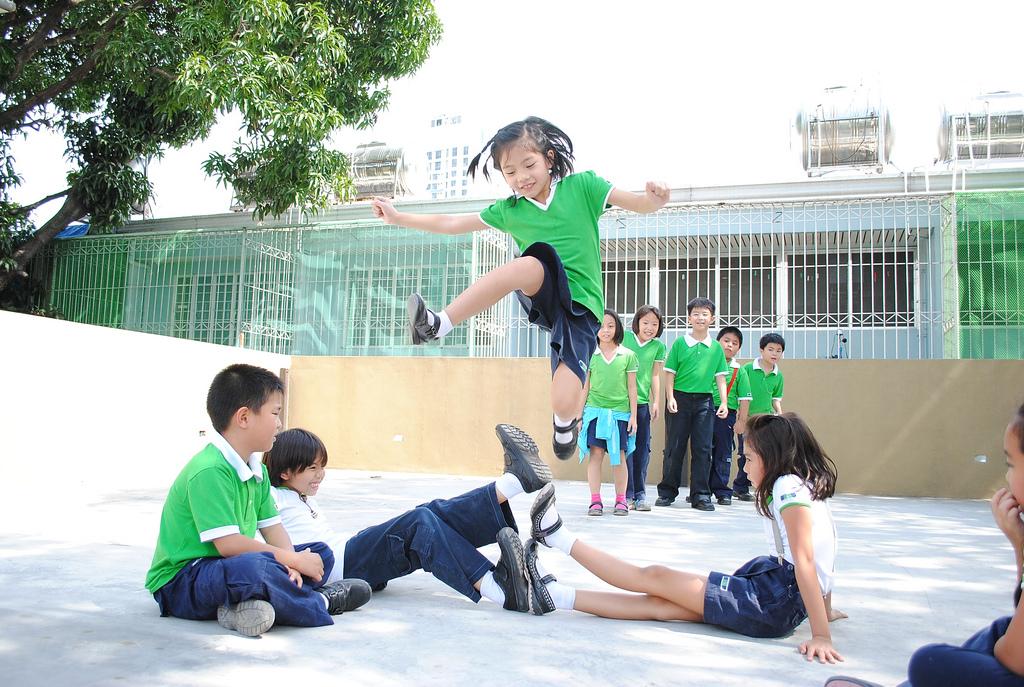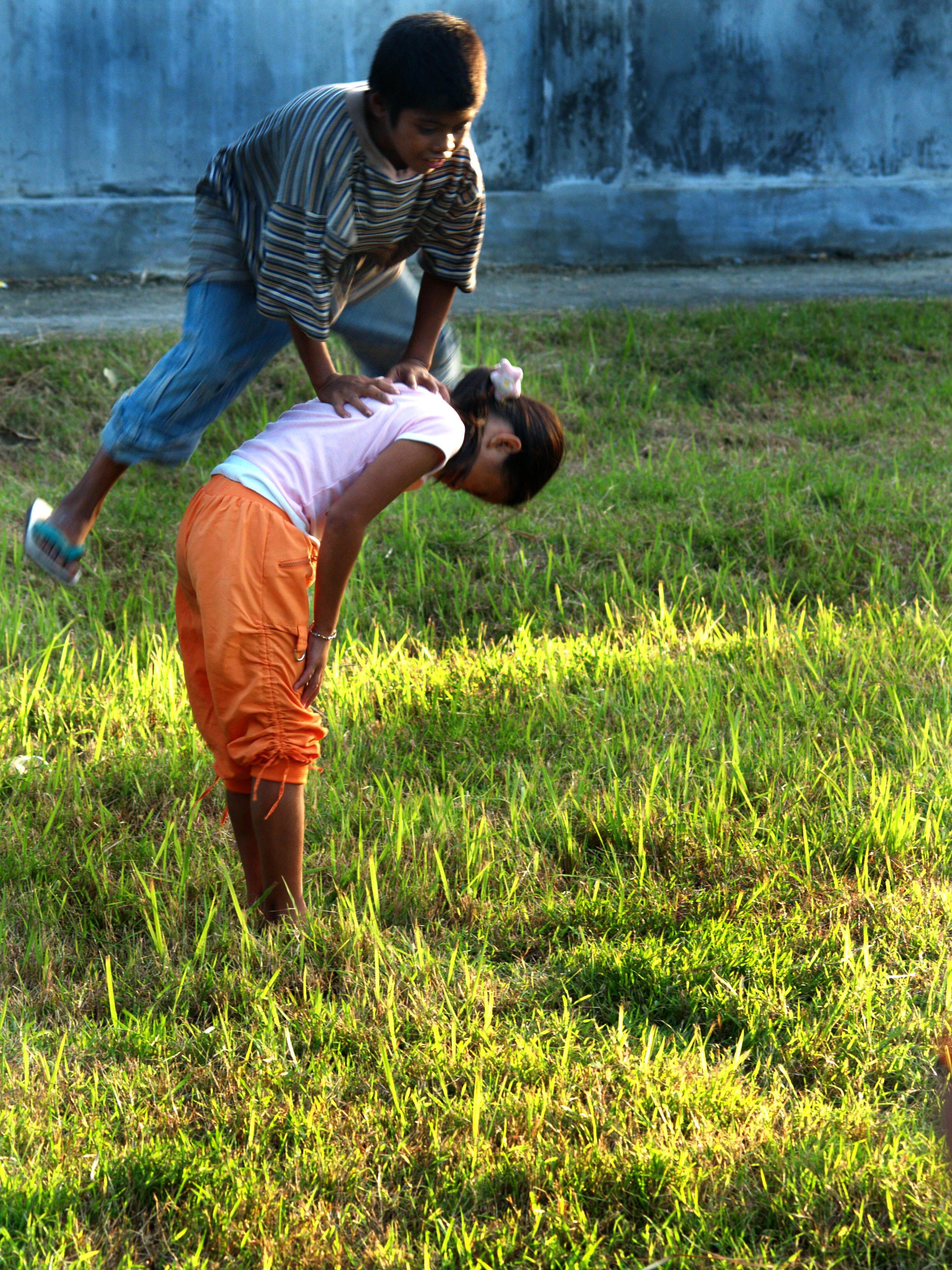
Grade School Students Playing Luksong Tinik - One of the Classic Filipino Games
There is no doubt that the Philippines is rich in culture and tradition. One of the most significant aspects of the country’s culture and traditions is the traditional games in the Philipppines. It is very popular among children because these are the games or sports that they usually play, and that no Filipino who grows up having no experience of these traditional games.
Piko, patintero, taguan, tumbang preso, siato, sipa and luksong tinik are some of the famous and favorite traditional games in the Philippines. Kids gather in the streets or the neighborhood playground to play these Pinoy games. They are popular and well-liked pastimes for many Filipinos, especially those of previous generations.
Traditional Filipino Sports are games that are being played by Filipino kids with the use of native materials and instruments. In spite of having a limited resource of toys, Filipinos don’t lose the joy of childhood because of the games being developed by their Filipino ancestors. It proves that they were very resourceful and creative in inventing the concept of “Larong Pinoy,” which is still alive up to this generation even though the new and modern forms of entertainment such as computer and foreign games nowadays have taken over the interests of the young. A majority of Filipino children still play the Filipino street games in any part of the country, in urban and rural areas alike.
Games such as Patintero, Tumbang Preso, Piko, Sipa, Turumpo, and many others, are still greatly alive and played daily in neighborhoods by children after school or during free time and weekends.
Filipinos should take care and value the essence of the Philippine culture and traditions and let it be passed on from generation to generation.

Luksong Baka
Philippine Traditional Games
Tumbang Preso
- Tumbang preso or presohan (tumba-patis in most Visayan regions) is a popular Filipino street game and is commonly seen in most Filipino movies and TV series.
- Like other Filipino traditional games, members take the following rules: one as the “taya”, someone who takes the rule of a-player-at-stake and holds the responsibility of the Lata (tin can), and; the two others as the players striking. The game is performed by having the players a “pamato” (which is ones own slipper) used for striking the tin that is held beside the taya.
- As to how the game cycles, the taya, is obliged to catch another player to take over his position of running after the tin that keeps from throwing away by the strikes of the players. Nevertheless, the taya is only privileged to do so only if the player is holding on his way a pamato and when the tin is on its upright position. Hence, running after another player is keeping an eye to the tin can’s position. As for the players, they have their whole time striking the tin can and running away from the taya keeping themselves safe with their pamato since making the tin fell down helps another player from recovering. Instance like having everyone had their turns over is one big climax of the game that leads them to panic since case is that taya has all his rights to capture whether the player have a hold of their pamato or not.
- However, mechanics also give each side privileges. With the roadway or streets as the area being performed, the taya take its place on one side held its tin centered on the ground while on the other end is bound by a line that limits the player when throwing. Breaking rules to the players give way for the taya to have his overturn, like: stepping on or outside the boundary line when throwing; kicking the tin; striking the tin without having oneself reaching the line; or even touching it.
- In other versions, especially those in Visayan regions and Southern Luzon, is of complexity for the part of the taya. The latter has to make the tin can stand upright together with its own “pamato” on the top of it which also adds up to the mechanics of the game. The tendency is that even when the taya has already made everything stood up but when the slipper will fall from the tin, he is not allowed catching anybody unless he hurriedly put it back to its position.
Luksong-Baka
- Luksong-Baka (lit. jump over the cow) is a popular variation of Luksong Tinik. One player crouches while the other players jump over him/her. The crouching player gradually stands up as the game progresses, making it harder for the other players to jump over him/her.Then he will be the taya if he dangled it the baka. It will repeat again and again until the players declare the player or until the players decide to stop the game.it is the Filipino version of leap frog
Luksong-Tinik
- Luksong-tinik (lit. jump over the thorns) two players serve as the base of the tinik (thorn) by putting their right or left feet together (soles touching gradually building the tinik). A starting point is set by all the players, giving enough runway for the players to achieve a higher jump, so as not to hit the tinik. Players of the other team start jumping over the tinik, followed by the other team members.
Piko
- Piko is the Philippine variation of the game hopscotch. The players stand behind the edge of a box, and each should throw their cue ball. The first to play is determined depending on the players' agreement (e.g. nearest to the moon, wings or chest). Whoever succeeds in throwing the cue ball nearest to the place that they have agreed upon will play first. The next nearest is second, and so on.
Agawan Base
- There are two teams with two bases. How many players on each team depends on the players. There are two bases which each team claims as their own. The goal is to tag the other team's base without getting tagged. If you're tagged, you're transferred to the other team and must be rescued. There are several variations in which the rules are changed, in some, you can connect other items on the base so you can easily touch the base.
- There are usually set points, such as first team to tag the other team 5 times wins. You can tag other people who has touched their base before you and are on the opposite team. If they've touched their base after you've touched your base, they can tag you, and you can't tag them.
Patay patayan
- Also referred to as Killer Eye. There should be at least 4 players. Cut pieces of paper according to how many players are playing. There should be 1 judge, at least 1 killer, at least 1 police, and others are normal people. The objective of the game is for the police to find and catch the killers by saying "I caught you" and say the name of the killer before the killer kindats (winks at) the judge. The killer gets to kill people by winking at the person he wants to kill. If he kills a normal person, the person says "I'm dead!" If he kills the judge without being caught, The judge says "I'm dead, but I'm the judge" and repeat again.
Sekqu Base
- Sekqu Base It is another version of Agawan Base but no score limits. If a team scores five, the game is still going on. The players can hide in other things near the enemy base and ambush them.
Agawang sulok
- Agawang sulok (lit. catch and own a corner) the it or tagger stands in the middle of the ground. The players in the corners will try to exchange places by running from one base to another. The it should try to secure a corner or base by rushing to any of those when it is vacant. This is called "agawan base" in some variants, and "bilaran" in others.
Araw-Lilim
- Araw-lilim - sun and shade - The it or tagger tries to tag or touch any of the players who is in direct contact with the light.
Bahay-Bahayan
- A role-playing game where children act as members of an imaginary family, sometimes to the extent that one of them becomes the family "pet." They then act out various household situations such as dinner, going to mass, and the like. there should be 4 to 5 players of it.
Hand clapping games
- A hand-clapping game generally involving 4 people. They are split into two pairs, a pair having 2 people facing each other, and all members from both pairs facing the center (the two pairs being perpendicular to each other). Each pair then does a hand clapping "routine" while singing the "bahay kubo" or "Leron-leron Sinta" At the middle of the song, each pair exchanges "routines"
Bati-Cobra
- This is a hitting and catching game. This game is played outdoors only by two or more players.
- To play this game, 2 pieces of bamboo sticks (1 long, 1 short) are required. A player acts as a batter and stands opposite the others players at a distance. The batter holds the long bamboo stick with one hand and tosses the short one with the other hand. The batter then strikes the shorter stick with the longer stick. The other players will attempt to catch the flying shorter stick. Whoever catches the stick gets the turn to be the next batter. If nobody catches the stick, any player can pick it up. The batter then puts down the longer stick on the ground. The holder of the shorter stick will throw it with the attempt to hit the longer stick on the ground. If the longer stick is hit, the hitter becomes the next Batter. If the player with the shorter stick misses to hit the longer one, the same batter will continue.
Bulong-Pari
- Bulong-Pari - whisper it to the priest - It is composed of two teams and an it. The leader of team A goes to the priest and whispers one of the names of the players of team B. Then he returns to his place and the priest calls out, "Lapit!" ("Approach!"). One of the players of team B should approach the priest, and if it happens to be the one whom the leader of team A mentioned, the priest will say, "Boom" or "Bung!" The player then falls out of line and stays somewhere near the priest as a prisoner.
Buwan-Buwan
- A rough circle is drawn on the ground and one person from the group is tagged. He is not allowed to enter the circle, but instead has to touch one of the people inside the circle without having entered it. If he succeeds, he can enter the circle, and the person touched becomes the next one tagged.
Calahoyo ("Hole-in")
- This is an outdoor game by two to ten players. Accurate targeting is the skill developed in this game because the objective of each player is to hit the anak (small stones or objects) with the use of the pamato (big, flat stone), trying to send it to the hole.
- A small hole is dug in the ground, and a throwing line is drawn opposite the hole (approx 5 to 6 metres (16 to 20 ft) away from the hole). A longer line is drawn between the hole and the throweing line. Each player has a pamato and an anak. All the anak are placed on the throwing line, and players try to throw their pamato into the hole from the throwing line. The Player whose pamato is in the hole or nearest the hole will have the chance for the first throw. Using the pamato, the first thrower tries to hit the anak, attempting to send it to the hole. Players take turns in hitting their anak until one of them gets into the hole, with the players taking turns a complete round and so on. The game goes on until only one anak is left outside the hole. All players who get their anak inside the hole are declared winners, while the one with the anak left outside the hole is the alila (loser) or muchacho. Alila or Muchacho will be 'punished' by all the winner/s as follows:
- Winners stand at the throwing line with their anak beyond line A-B (longer line between hole and throwing line). The winners hit their anak with their pamato. The muchacho picks up the pamato and returns it to the owner. The winners repeat throwing as the muchacho keeps on picking up and returning the pamato as punishment. Winners who fail to hit their respective anak will stop throwing. The objective is to tire the loser as punishment. When all are through, the game starts again.
Chinese Garter
- Two people hold both ends of a stretched garter horizontally while the others attempt to cross over it. The goal is to cross without having tripped on the garter. With each round, the garter's height is made higher than the previous round (the game starts with the garter at ankle-level, followed by knee-level, until the garter is positioned above the head). The higher rounds demand dexterity, and the players generally leap with their feet first in the air, so their feet cross over the garter, and they end up landing on the other side. Also, with the higher levels, doing cartwheels to "cross" the garter is allowed.
Declan Ruki
- Declan Ruki - I declare, do it! - Participants are told to do something by the winner of the previous games. It is similar to the game Simon Says.
Holen
- You should hold the ball called holen in your hand then throw it to hit the players ball out of the playing area. Holen is called marble in USA. It is played a more precise way by tucking the marble with your 3rd finger, the thumb under the marble, the fourth finger used as to stable the marble. You aim at grouped marbles inside a circle and flick the marble from your fingers and anything you hit out of the circle is yours. Who ever got the most marbles win the game. You can also win the game by eliminating your opponent by aiming and hitting his marble. You have to be sharp shooter to be a winner.
Iring-Iring
- Iring-Iring - go round and round until the hanky drops - After the it is determined, he or she goes around the circle and drops the handkerchief behind a person. When the person notices the handkerchief is behind his/ her back, he or she has to pick up the handkerchief and go after the it around the circle. The it has to reach the vacant spot left by the player before the it is tagged; otherwise, the it has to take the handkerchief and repeat the process all over again.
Jack 'n' Poy
- This is the local version of Rock-paper-scissors. Though the spelling seems American in influence, the game is really Japanese in origin (janken) with the lyrics in the Japanese version sounding very similar to the "gibberish" sung in the Philippines.
The lyrics: “Jack and Poy, hale hale hoy, sinong matalo syang unggoy!”
Juego de Anillo
- A game notably Spanish in influence. The name literally translates to "game of rings." It involves riding a horse while holding a dagger and "catching" rings hanging from a tree or some other structure using the dagger. But now, people usually play this game nowadays by riding a bicycle while holding a dagger.And the competitors need to continue their speed in riding their bicycle.
Juego de Prenda
- Juego de prenda - game of looking for the missing bird - There is no limit to the number of players that can play. Players sit in a circle with the leader in the middle. Each player adopts a name of a tree or flower that is given by the leader. The leader recounts the story of a lost bird that was owned by a king. He or she says, The bird of the king was lost yesterday. Did you find it, Ylang-Ylang? The player who adopted the name of the Ylang-Ylang tree at once answers that he or she has not found it, so the leader continues to ask the other trees whether the bird has hidden in them. If a player cannot answer after the third count, he or she is made to deposit a thing he or she owns to the leader until the leader has been able to gather a lot of things from the members.The Boy is choosing a tree.The Girl is choosing a flower.The one participants will be a king
Kapitang Bakod
- Kapitang bakod - touch the post, or you're it! or hold on to the fence - When the it or tagger is chosen, the other players run from place to place and save themselves from being tagged by holding on to a fence, a post, or any object made of wood or bamboo.
Langit-Lupa
- Langit-lupa (lit. heaven and earth) one it chases after players who are allowed to run on level ground (lupa) and clamber over objects (langit). The "It" may tag players who remain on the ground, but not those who are standing in the "langit" (heaven). The tagged player then becomes "It" and the game continues.
- In choosing who the first "It" is usually a chant is sung, while pointing at the players one by one:
- Langit Lupa impyerno, im im impyerno Sak-sak puso tulo ang dugo Patay, buhay, Umalis ka na sa pwesto mo! when the song stops and a player is pointed at they are "out" and the last person left is the "It"
Lagundi
- A game of Indian influence. Basically game of tag, except here, the divide into two teams,the "it" team members get to hold the ball, passing it between themselves, with the of the ball touching the head of the other (not "it") team.
Lawin at Sisiw ("Hawk and Chicken")
- This game is played by 10 or more players. It can be played indoors or outdoors.
- One player is chosen as the 'hawk' and another as the 'hen'. The other players are the 'chickens'. The chickens stand one behind the other, each holding the waist of the one in front. The hen stands in front of the file of chickens.
- The hawk will 'buy' a chicken from the hen. The hawk will then take the chicken, asks him/her to hunt for food and goes to sleep. While the hawk is asleep, the chicken will return to the hen. The Hawk wakes up and tries to get back the chicken he bought while the hen and other chickens prevent the hawk from catching the chicken. If the hawk succeeds, the chicken is taken and punished. If the hawk fails to catch the chicken, the hawk will try to buy the chicken. The game actually came from Japan. There, it is known as Janken.
Palosebo
- Palo-sebo - greased bamboo pole climbing - This game involves a greased bamboo pole that players attempt to climb. This games is usually played during town fiestas, particularly in the provinces. The objective of the participants is to be the first person to reach the prize—a small bag—located at the top of the bamboo pole. The small bag usually contains money or toys.
Pitik-Bulag
- This game involves 2 players. One covers his eyes with a hand while the other flicks a finger (pitik) over the hand covering the eyes. The person with the covered eyes gives a number with his hand the same time the other does. If their numbers are the same, then they exchange roles in the game
Presohan
- See "Tumbang Preso"
Sambunot
- Sambunot is a Philippine game which may be played outdoors by ten or more players, but not to exceed twenty. The goal in the game is to get the coconut husk out of the circle.
- A circle is drawn on the floor, big enough to accommodate the number of players. A coconut husk is placed at the center of the circle. The players position themselves inside the circle. At the signal ″GO,″ players will rush to the center to get the coconut husk. Players may steal the coconut husk from another player in an attempt to be the one to take the husk put of the circle. A player who is successful in getting out of the circle with the coconut husk wins, and the game starts again.
Sawsaw-Suka
- The name literally translates to "dip into vinegar." The "it" has his palm open while the other players touch this with their index fingers, singing "sawsaw suka/ mahuli taya!" which translates to "dip into the vinegar/the last one (or the caught one) becomes "it". And indeed, the "it" tries to catch any player's finger at the end of the song.
Sipa
- Sipa - game of Kick - The object being used to play the game is also called sipa. It is made of a washer with colorful threads, usually plastic straw, attached to it. The sipa is then thrown upwards for the player toss using his/her foot. The player must not allow the sipa to touch the ground by hitting it several times with his/her foot, and sometimes the part just above the knee. The player must count the number of times he/she was able to kick the sipa. The one with most number of kicks wins the game.
- The game mechanics of Sipa is similar to the Western game called Hacky Sack. Sipa is also played professionally by Filipino athletes with a woven ball, called Sepak Takraw, with game rules borrowed from our Southeast Asian neighbor, Indonesia.
Taguan
- Taguan - hide and seek in America. What is unique in Tagu-Taguan compared to its counterpart, hide and seek, is that this game is usually played at sunset or at night as a challenge for the it to locate those who are hiding under the caves in laguna cavite which is a popular site for pro taguan players
Takip-Silim
- Takip-silim - twilight game, look out, cover yourself! or take-cover game! - Participants usually step on couches, hide under tables, or wrap themselves in curtains – much to the dismay of neat-freak parents.
Ten-Twenty
- A game involving 2 pairs, with one utilizing a stretched length of garter. One pair faces each other from a distance and has the garter stretched around them in such a way that a pair of parallel lengths of garter is between them. The members of the other pair, then begin doing a jumping "routine" over the garters while singing a song ("ten, twenty, thirty, and so on until one hundred). Each level begins with the garters at ankle-height and progresses to higher positions, with the players jumping nimbly on the garters while doing their routines.
Tinikling
- A game variant of the tinikling dance, with the same goal - for the players to dance nimbly over the clapping bamboo "maw" without having their ankles caught.
Tsato
- Tsato - stick game, better be good at it - Two players, one flat stick (usually 3') and one short flat piece of wood (4" usually a piece cut from the flat stick).
- Player A hitter and Player B as the catcher. Played outside on the ground where you dig a small square hole (slanted) where you put the small wood so it sticks out.
- Player A hits the wood with the stick so it catches air enough to be hit by the stick.
- The further the wood gets hit the more points you get (usually counted by the number of stick length
- Player B on the other hand has to anticipate and catch the small piece of wood to nullify the points and become his turn OR looks forward to Player A to miss hitting the wood.
Ubusan Lahi
- Ubusan lahi - clannicide - One tries to conquer the members of a group (as in claiming the members of another's clan). The tagged player from the main group automatically becomes an ally of the tagger. The more players, the better. The game will start with only one it and then try to find and tag other players. Once one player is tagged, he or she then will help the it to tag the other players until no other participant is left. Some people also know this as Bansai.
Teks
- Teks or teks game cards - texted game cards - Filipino children collect these playing cards which contain comic strips and texts placed within speech balloons. They are played by tossing them to the air until the cards hit the ground. The cards are flipped upwards through the air using the thumb and the forefinger which creates a snapping sound as the nail of the thumb hits the surface of the card. The winner or gainer collects the other players' card depending on how the cards are laid out upon hitting or landing on the ground.










